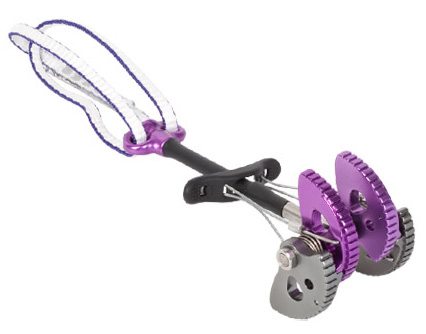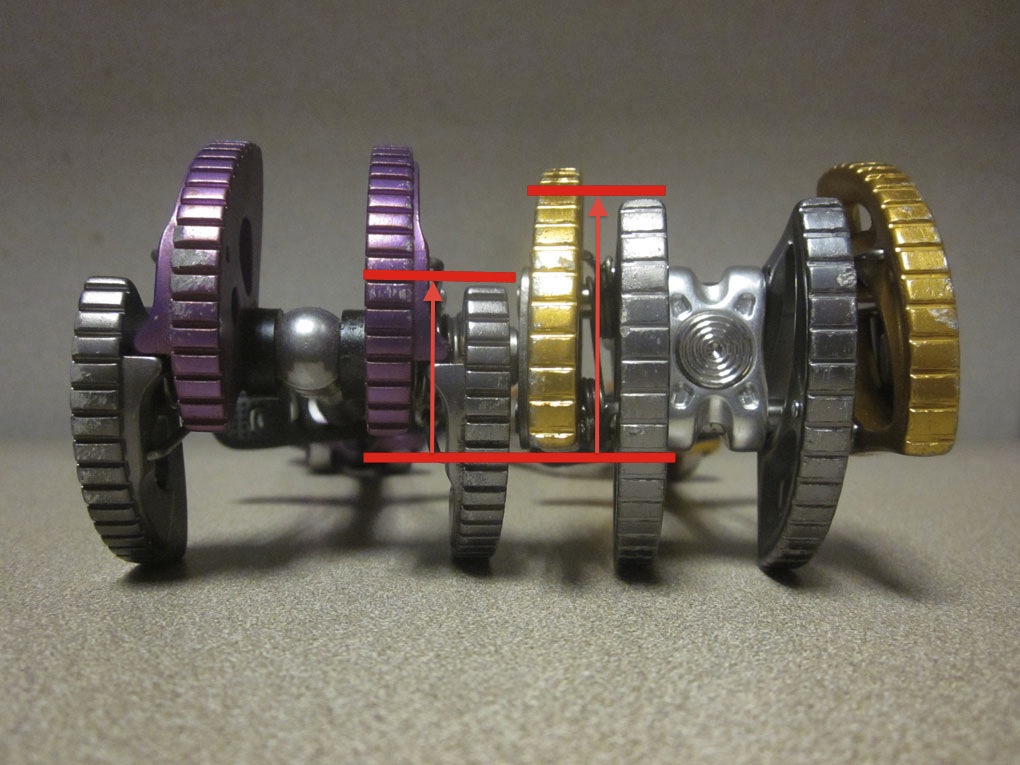DMM Demon Cams
Features
- A lightweight single axle, single stem cam
- Special thumb grip and trigger bar for easy handling
- Original 13.75° camming angle
- Cam stops for 10kN in passive position
- Fitted with extendable 8mm Dyneema slings
- Colour coded to help you make a speedy identification
- Nine Sizes
Range: 13-100mm
Days Tested: 5
Test Locations: Indian Creek and Castle Valley, Utah; Eldorado Canyon and Lumpy Ridge, Colorado
On their product page, DMM describes the motivation for creating their Demon Cam as follows:
“In order to provide more racking options in our active protection range we have combined some of our favourite features from our two existing cams: the tried and trusted 13.75°, single axle head unit of the 4CU, with the justifiably popular stem assembly of the Dragon with its patented thumb press and extendable sling design.”
When first looking this over, it didn’t strike me as an inspired moment of design. Making a new cam line out of a collection of existing features seemed like pulling together a Frankenstein-like solution to a problem that didn’t exist. So it’s fair to say that the Demon cam doesn’t bring to the table anything new for those already familiar with DMM’s other cam lines, but this shouldn’t be held against the Demon either. It’s a strong offering for those who like most of the functional aspects of the Dragon, but prefer a single-axle design (similar to the Wild Country Helium Friends) to a double-axle head (the trademark of the DMM Dragon and the Black Diamond C4).
Nuts and Bolts
Because DMM describes the Demon as somewhat of a “dream team” of cam features, I think the best way to review the cam is to break down the features individually before talking about how the cam works on real rock.
 But before going further, it is important for me to note that I tested only the purple size 3 cam, which covers a usable range of 43-66mm (comparable to the Helium Friend size 3, or the C4 size 2). While the features described below are consistent across the entire Demon line, I don’t want to extrapolate unfairly on my experience using them to describe the other sizes in the line; even cams within the same line perform differently as size changes.
But before going further, it is important for me to note that I tested only the purple size 3 cam, which covers a usable range of 43-66mm (comparable to the Helium Friend size 3, or the C4 size 2). While the features described below are consistent across the entire Demon line, I don’t want to extrapolate unfairly on my experience using them to describe the other sizes in the line; even cams within the same line perform differently as size changes.
Head
Starting with the head of the cam, the Demon bears a strong resemblance to classic Wild Country designs: four cam lobes, built on a 13.75° cam angle, and one axle holding it all together. At 13.75°, the cam angle is squarely in the middle of pack—bigger than Metolius cams, smaller than Black Diamond cams.
The purple Demon weighs in at 154g, making it a hair lighter than the gold number 2 C4 (though it should be noted that the C4 has an ever-so-slightly wider range), and 9g heavier than the number 3 Helium Friend. While I do think that the weight of a piece of gear is a characteristic that is generally worthy of mention, the take-home here is that the cam is not heavier or lighter than comparably-sized competitors for it to be noticeable in the field. That said, the Demon cams, like the Dragons, carry more weight in the head relative to their overall weight than most other cams (because of a slightly shorter stem), inching the center of mass forward slightly. While this isn’t enough to make them hard to maneuver, it does make them feel slightly heavier in the hand than they actually are.
The lobes of the Demon are slightly smaller than those on a comparably sized Dragon or C4, but the head of the Demon cam is actually the widest of the three. The reason for this is that the double-axle design of the Dragon and C4 (see below right) offsets the lobes in such a way that the overlap packs slightly more lobe material into a smaller space. To a similar extent, the head of the demon cam is broader than either the Dragon or C4 of similar size.

This is likely to also be a consequence of the axle choice: a single-axle cam will have one thicker spring set between the lobes on each side, whereas a double axle head will have four springs (two on each side), enabling the use of two thinner springs side-by-side on each half of the head such that the lobes can sit slightly closer together. As a result, the Demon cam might take up slightly more room on your rack than either the Dragon or C4, but we are talking about slim margins here, so it is unlikely that you would notice this difference if you weren’t looking for it.
The last major point about the head design is that the cam is rated to 10kN when placed passively. This was a real surprise, especially because it’s easily lost in the list of technical specs on DMM’s website. Previously, I had held the belief that the best part of a double-axle cam design was the fact that the offset lobes allowed the cams to be placed in passive positions. Single-axle cams make use of cam stops on the inside of the lobes to stop the lobes from capsizing when the cam is not in use. To fall on such a cam when placed passively is to apply all of the force of the fall directly onto the cam stops. The force, in these cases, is shear force (as opposed to normal force, for any engineers in the room) and can easily break cam stops that aren’t rated to full strength.
Presumably by beefing up the cam stops, DMM has broken that barrier for single-axle cams. While it’s true that some other single-axle cams (such as Metolius Mastercams) have thicker cam stops as well (and the larger sizes might even hold a fall), they’re not specifically rated for this sort of use. Metolius describes passive placement as improper use of the cam. While passive placement of a Demon cam is not rated to the same strength as an active placement (or even a passive placement for a double-axle cam), 10kN is substantial, and I would happily whip on that all day, confident that I’d never come close to 10kN. (For those keeping score at home, 10kN translates to nearly 2,250 pounds of force.)
Granted, it’s a rare moment that you’re placing your cams in passive placements, but in my mind, there’s no reason why they shouldn’t be rated for this, and DMM deserves praise for going out of their way to get this done.


This is a great review. I just randomly stumbled across it. One of the best I’ve read.
Thanks,